Transform Your Kitchen with Lush Plants
Turning your kitchen into a lively, natural space is easy. Adding kitchen plants can make your cooking area feel fresher, cleaner, and more inspiring. Whether you're good with plants or just starting, adding greenery can make your kitchen feel new and exciting.
There are many plants that do well in kitchens, from herbs to vines and succulents. They not only look great but also help clean the air and give you fresh ingredients. Start exploring to find the best plants to make your kitchen a greener, more vibrant place.
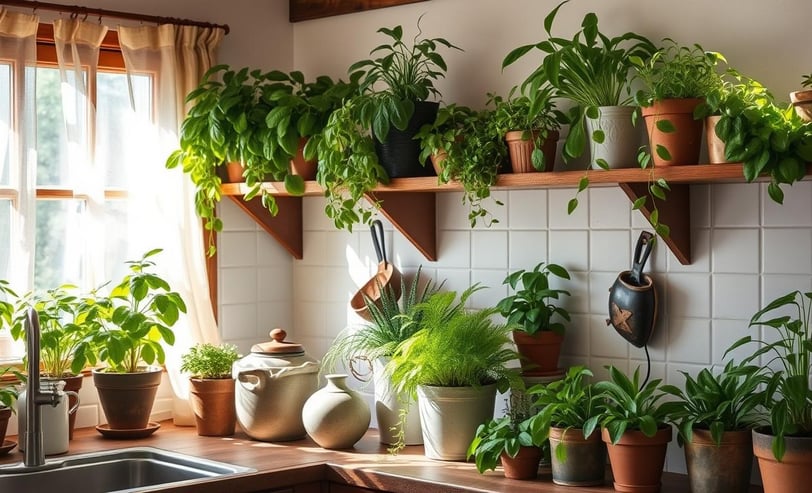

Key Takeaways
Incorporating plants in your kitchen can enhance the ambiance and air quality.
Kitchen plants offer a wide range of practical and aesthetic benefits.
Diverse options, from herbs to succulents, can thrive in kitchen environments.
Introducing greenery can inspire new culinary creativity and experiences.
Transforming your kitchen with plants is a simple and rewarding project.
Why Adding Plants to Your Kitchen Makes Perfect Sense
Turning your kitchen into a green oasis brings natural beauty and practical benefits. It improves air quality and creates a calming atmosphere. Adding kitchen plants ideas can change your home for the better.
Health Benefits of Kitchen Greenery
Adding plants like the Peace Lily in Pot or Snake Plant in Decorative Pot can improve air quality by removing toxins. These air-purifying plants are great for kitchens where cooking might release pollutants, making your space healthier and more inviting.
Creating a Natural Atmosphere
Kitchen plants turn a cold kitchen into a cozy space. Their greenery brings peace, balancing the kitchen's busy vibe. This makes cooking more enjoyable and the kitchen more beautiful.
Environmental Impact
Using eco-friendly kitchen decor with plants also helps reduce your environmental footprint. Grow fresh herbs like basil, thyme, and mint with the Mason Jar Herb Garden Kit or a Hydroponic Herb Garden Kit, which makes it easy to cultivate herbs indoors.
Adding plants to your kitchen is a smart move. It boosts your health, creates a peaceful space, and supports the environment. Choose from easy-to-care-for succulents, fragrant herbs, or lush plants. The advantages of kitchen plants are clear.
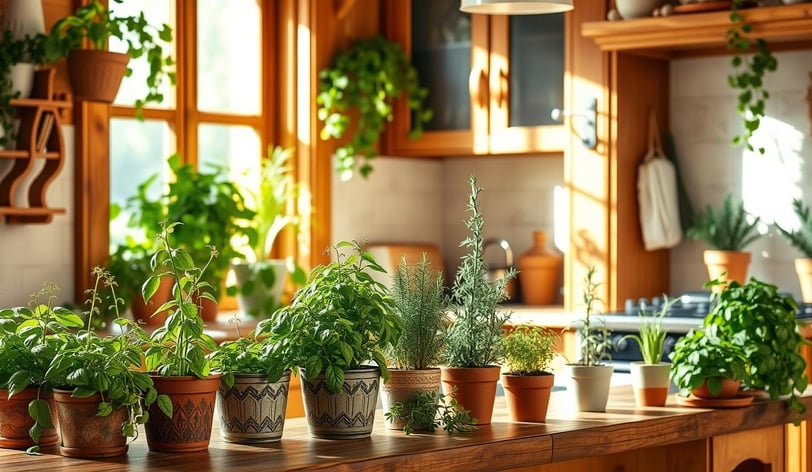

Best Kitchen Plants for Different Light Conditions
Bright Light
Sun-loving plants like succulents and citrus trees thrive near windows.
A Succulent Collection (Set of 5)
is perfect for adding color and texture to sunny spots.
Low Light
If your kitchen lacks natural light, opt for hardy plants like pothos, peace lilies, or ZZ plants. Pair them with an Adjustable LED Grow Light Strip to ensure they flourish in dim spaces.
Medium Light
For kitchens with moderate lighting, Chinese evergreens or parlor palms are ideal. Use stylish Ceramic Window Sill Planters to showcase these plants and enhance your kitchen decor.
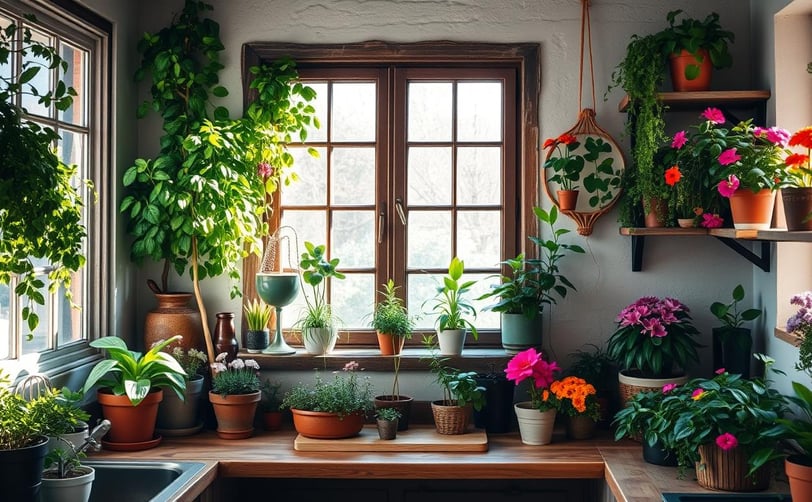

Low-Maintenance Kitchen Plants for Busy Cooks
For busy home cooks, finding the right plants that require minimal effort is crucial.
Drought-Resistant Options: Succulents like jade plants and hardy snake plants are perfect for forgetful plant parents. Use a Self-Watering Planter to keep them hydrated without worry.
Hardy Varieties for Beginners: Start with a Live Kitchen Herb Plants Starter Kit featuring easy-to-grow options like basil, mint, and rosemary for both decor and culinary use.
Drought-Resistant Options
For those who aren't great with plants, try succulents and cacti. These beginner-friendly kitchen greenery need little water and can handle neglect. Jade plants, snake plants, and ZZ plants are great for adding nature to your kitchen without needing constant care.
Self-Watering Solutions
Forgetful about watering? Self-watering planters are a lifesaver. They have a reservoir that slowly feeds water to the roots. This keeps your easy-care kitchen plants watered even when you're busy cooking. Snake plants, philodendrons, and pothos work well with these planters.
Hardy Varieties for Beginners
New to indoor gardening? Start with hardy low-maintenance indoor plants. ZZ plants, succulents, and Chinese evergreens are easy to care for. They're perfect for beginner-friendly kitchen greenery.
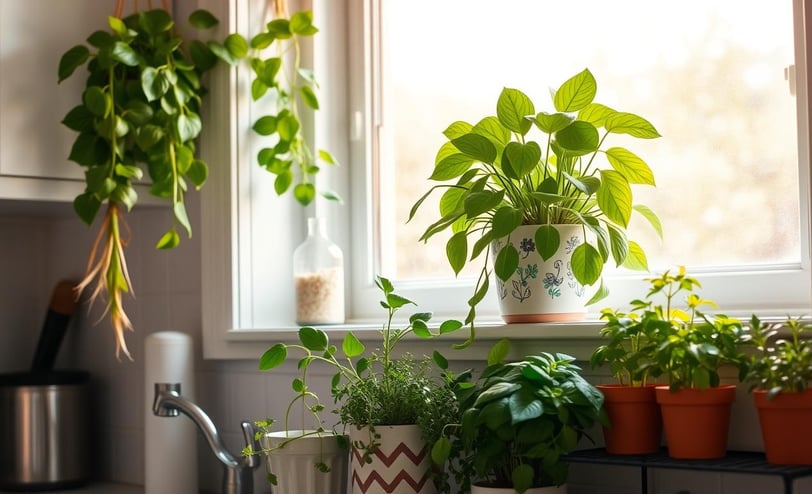

Adding these low-maintenance kitchen plants to your space brings nature's beauty without stress. Choose from drought-resistant, self-watering, or hardy plants. Your kitchen will become a peaceful, plant-filled haven.
Herbs That Thrive in Kitchen Environments
Growing fresh herbs in your kitchen is simple and rewarding. A Mason Jar Herb Garden Kit or Vertical Wall Planter System lets you grow flavorful herbs like basil, thyme, and mint while saving counter space.
Popular Herbs and Their Uses:
Basil: Perfect for pesto, salads, and tomato dishes.
Thyme: Ideal for roasted meats, soups, and stews.
Mint: Great for summer drinks and desserts.
With tools like a Plant Pruning Shears Set, you can easily trim and maintain your herb garden for optimal growth.
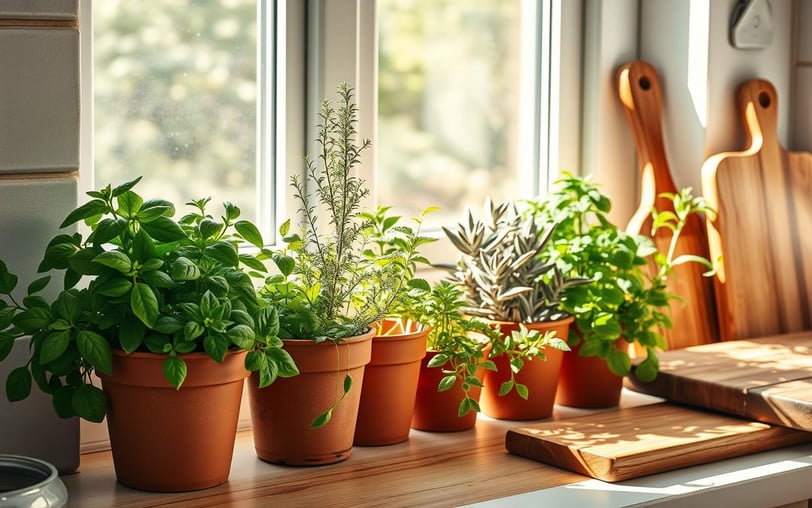

Creative Kitchen Plants Display Ideas
Decorating your kitchen with plants can transform your space. Here are some creative ideas:
Vertical Gardens
Save space with a Vertical Wall Planter System to grow herbs or small vegetables. It’s a stylish and functional way to bring greenery into compact kitchens.
Window Sill Arrangements
Place potted herbs or succulents in Ceramic Window Sill Planters for a clean, elegant look. The natural light helps these plants thrive while adding charm to your kitchen.
Countertop Displays
For a modern twist, use a Tiered Plant Stand to organize multiple plants. This keeps greenery accessible for cooking and adds visual interest to your counters.
Vertical Garden Solutions
Vertical gardens are perfect for small kitchens. They let you grow herbs, greens, and small veggies on your walls. These systems save space and add beauty to your kitchen. A vertical herb garden near your cooking area is super convenient.
Window Sill Arrangements
Using your kitchen's window sills is a timeless choice. Place potted plants, succulents, or vines on the sill. This makes your plants a natural highlight and lets them soak up sunlight.
Counter-top Displays
For a neat and handy kitchen plant displays option, try counter-top arrangements. Group plants or a vertical herb garden on your counters. This keeps your plants close for cooking and makes them a part of your kitchen's beauty.
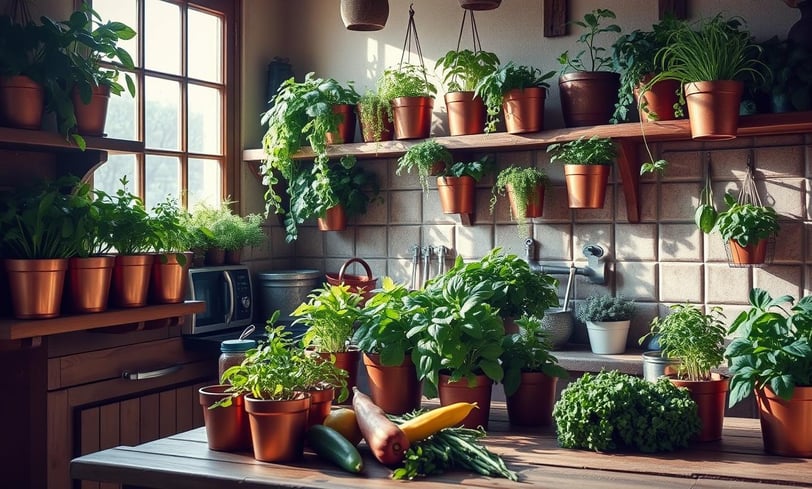

Air-Purifying Kitchen Plants
Keeping the air in your kitchen clean is key. Cooking can bring in pollutants. Luckily, air-cleaning plants are a natural fix. These plants help remove kitchen pollutants, making the air healthier to breathe.
The Peace Lily is a top pick for kitchens. It's known for pulling out harmful stuff like benzene and formaldehyde. Its big leaves act as air filters, making it a great kitchen addition.
The Spider Plant is another favorite. It loves light and can cut down formaldehyde levels by up to 90%.
The English Ivy is also great. It can tackle airborne mold and bacteria, common in kitchens.
For a tropical feel, try the Bamboo Palm. It's good at removing xylene and toluene from the air.
Adding these air-cleaning plants to your kitchen boosts air quality and looks nice. Let nature help make your kitchen a better place to be.
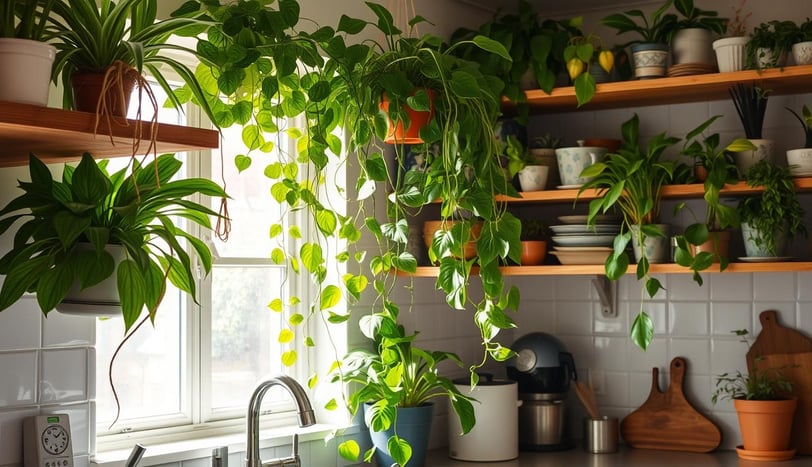

Humidity-Loving Plants for Kitchen Spaces
Creating a lush kitchen oasis is easy with high-humidity plants. These plants love the kitchen's humid air. They add elegance and greenery to your cooking space.
Managing Moisture Levels
Success with these plants depends on managing moisture. They need consistent humidity to grow well. Use a humidifier or mist them often to keep the right humidity.
Best Placement Tips
Choose bright spots near sinks, stoves, or windows for natural humidity.
Group plants together for a lush, jungle look.
Stay away from direct drafts or vents to prevent drying out.
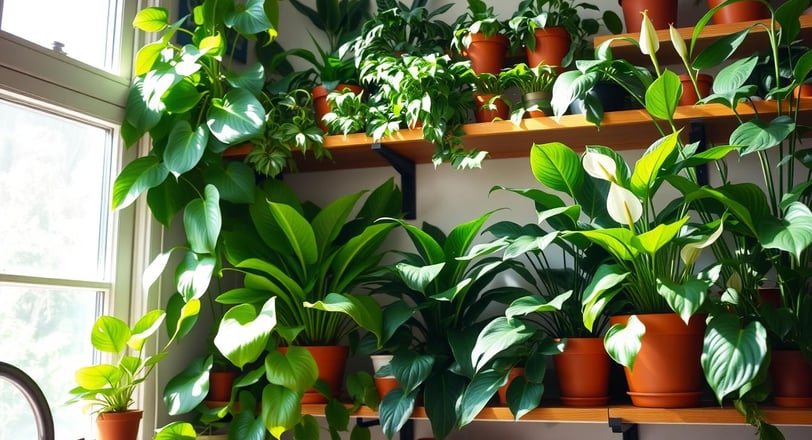

Adding these tropical kitchen plants can turn your kitchen into a green oasis. It looks great and improves the air and cooking experience.
Avoiding Common Kitchen Plant Mistakes
Overwatering: Use an Indoor Plant Moisture Meter to ensure you’re not overwatering your plants.
Insufficient Lighting: Place plants in bright areas or supplement light with a Grow Light Strip.
Pests: Regularly check plants for pests and use natural remedies to keep them healthy.
Overwatering: The Green Thumb's Downfall
Overwatering is a big problem for kitchen plants. Too much water can cause root rot and fungal infections. Always check the soil before watering and know your plant's needs.
Insufficient Lighting: A Shady Situation
Kitchens often don't have enough natural light for plants. Without enough light, plants can become weak and unhealthy. Place plants in bright spots or use grow lights to help.
Pest Infestations: Unwanted Visitors
Kitchens can attract pests that harm plants. Aphids, spider mites, and mealybugs are common pests. Regularly check your plants and use organic pest control to keep pests away.
Neglect: The Silent Killer
It's easy to forget about plants in a busy kitchen. Neglect can make plants wilt and unhealthy. Make sure to regularly water, prune, and check on your plants.
By avoiding these mistakes, you can create a beautiful, low-maintenance indoor garden. It will make your kitchen more welcoming and functional.
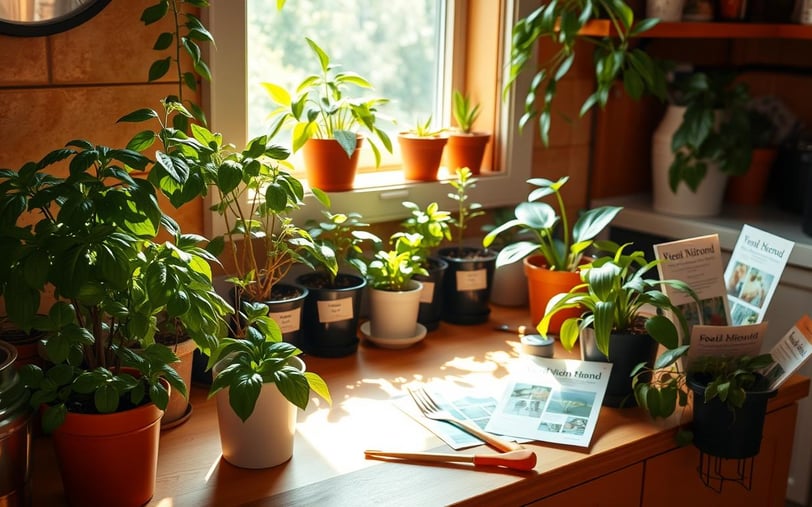

Seasonal Care Tips for Kitchen Plants
To keep your kitchen plants healthy, you need to change how you care for them with the seasons. Knowing what your plants need at different times helps them grow well. This makes your cooking space more lively.
Winter Protection Strategies
When it gets colder and darker, your plants need extra care. Here are some tips to protect them:
Water them less to avoid root rot and let the soil dry out.
Keep plants away from cold drafts by windows or doors.
Use a grow light or place them near a sunny window for more light.
Keep the temperature around your plants steady to avoid shock.
Summer Growth Management
In summer, your plants grow fast and need more care. Here's how to help them thrive:
Water them more often to keep the soil moist but not too wet.
Trim and prune them often to keep their shape and encourage growth.
Feed them with a balanced fertilizer to support their growth.
Watch for pests and deal with them quickly to protect your plants.
By adjusting your care for the seasons, your kitchen plants will stay healthy and vibrant. They'll add to the beauty of your cooking space.
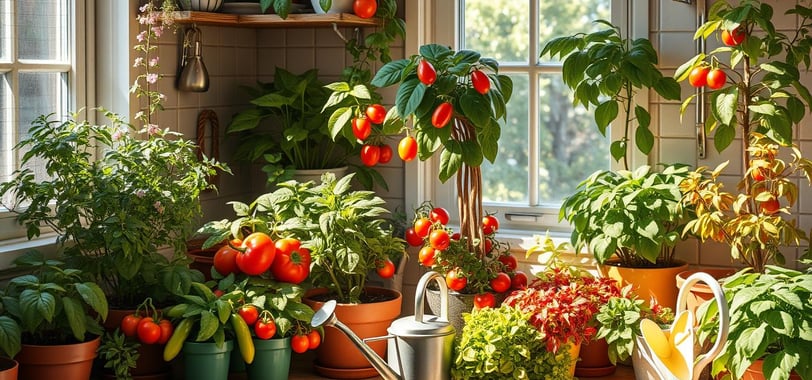

Kitchen Plants That Complement Your Cooking
Make your cooking better by adding aromatic and edible kitchen plants. They look great and make your food taste better. These plants turn your kitchen into a feast for the senses.
Basil, rosemary, and thyme are great herbs for many dishes. They add depth to tomatoes, meats, and more. Try adding edible flowers like nasturtiums, marigolds, or violas for color and a floral taste in salads and desserts.
For new recipes, try lemon balm for a citrus flavor or lavender for sweet dishes. These plants make your kitchen look and smell amazing. They also make your meals more enjoyable for everyone.
FAQ
What are the benefits of adding plants to my kitchen?
Adding plants to your kitchen can improve air quality. It also makes your space feel more natural and inviting. Plus, you can use herbs and edible flowers in your cooking.
What are the best plants for different light conditions in the kitchen?
Choose plants based on your kitchen's light. Low-light spots are perfect for ZZ plants, snake plants, and pothos. Bright areas are great for herbs and succulents.
Medium-light spots can handle a variety of plants. Think about philodendrons, Chinese evergreens, and peace lilies.
What are some low-maintenance kitchen plants for busy cooks?
Busy cooks should look for plants that need little care. Succulents, air plants, and cast-iron plants are good choices. Self-watering planters make care even easier.
For beginners, try snake plants, ZZ plants, and Chinese evergreens. They're hardy and easy to care for.
What herbs can I grow in my kitchen?
Many herbs grow well indoors. Try basil, rosemary, thyme, oregano, and mint. They add flavor to your cooking and are easy to use every day.
How can I display plants creatively in my kitchen?
Be creative with your plant displays. Use vertical gardens to save space. Hang baskets or planters on walls.
Windowsills are great for plants like herbs and succulents. Use stylish planters or tiered stands on countertops to show off your plants.
What air-purifying plants work well in the kitchen?
Some plants clean the air in your kitchen. Peace lilies, English ivy, snake plants, and Chinese evergreens are good choices. They help remove pollutants and improve air quality.
How can I care for humidity-loving plants in my kitchen?
Humidity-loving plants do well in kitchens. Check humidity levels and use a pebble tray or mist plants. Place them near sinks or windows for extra moisture.
What common mistakes should I avoid when growing plants in the kitchen?
Don't overwater or neglect lighting. Make sure plants have good drainage and the right amount of sunlight. Check for pests or disease regularly to keep your plants healthy.
How do I care for my kitchen plants throughout the seasons?
Seasonal care is key for your plants. In winter, protect them from cold and provide extra light. In summer, prune, fertilize, and adjust watering to keep them healthy.
What plants can I choose that will complement my cooking?
Choose plants that enhance your kitchen and cooking. Aromatic herbs like basil and rosemary are great. Edible flowers like nasturtiums and violas add flavor and beauty to dishes.
